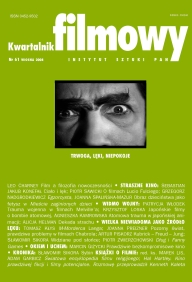Tożsamość traumatyczna w japońskich filmach o bombie atomowej
Traumatic Identity in Japanese Films about the Atom Bomb
Author(s): Krzysztof LoskaSubject(s): Theatre, Dance, Performing Arts
Published by: Instytut Sztuki Polskiej Akademii Nauk
Keywords: Japanese Cinema; hibakusha; war; trauma; atom bomb
Summary/Abstract: The author starts his article by defining trauma, its causes and relation to mass killings and its impact on the human psyche. He then relates that to the theme of “hibakusha” – or the victims of the atom bombs that fell on Hiroshima and Nagasaki in 1945, the people who, although escaped death, suffered from radiation sickness, infertility and post traumatic stress disorder. The author seeks out signs and symptoms of this mass experience of trauma in films, such as “Genbaku no ko” by Kaneto Shindo (1952), “Children of Nagasaki” / ”Nagasaki no ko” by Sotoji Kimura (1957), “Hiroshima, mon amour” by Alain Resnais (1959), that deal directly with wartime events, but also in films that are more allegorical in the way they present fear of nuclear mass destruction (“Godzilla” / “Gojira”/ Ishiro Honda, 1954), as well as films that deal with the problem in a less direct way. (For example Akira Kurosawa’s “Dreams” / ”Yume”, (1990) and “Rhapsody in August” / “Hachigatsu no kyoshikyoku”, 1991). Loska points out that filmmakers dealing the Hiroshima and Nagasaki tragedy faced the enormous problem of expressing or rather the inability to express, that which is beyond reason and simple thought categories.
Journal: Kwartalnik Filmowy
- Issue Year: 2008
- Issue No: 61
- Page Range: 101-111
- Page Count: 11
- Language: Polish

